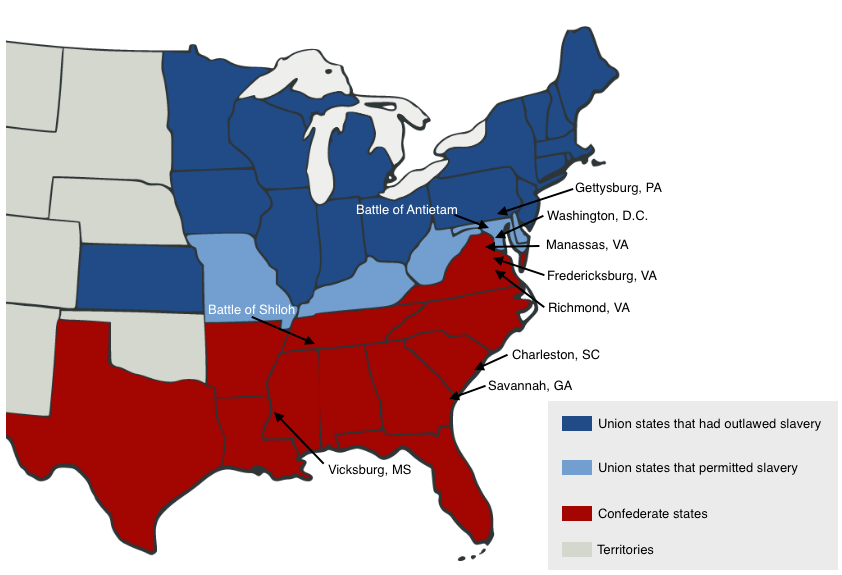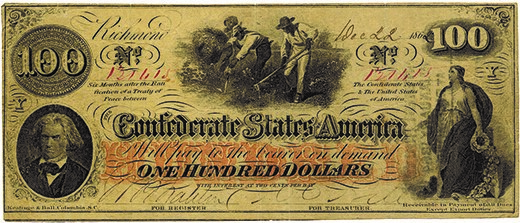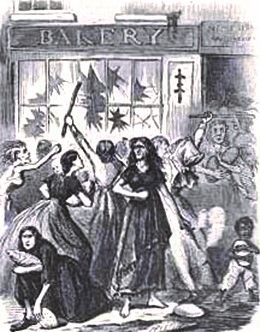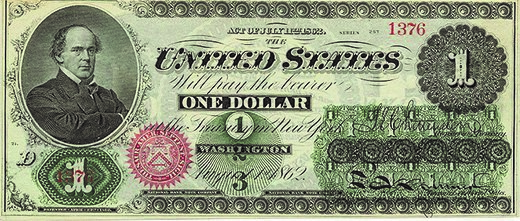Table of Contents |
At the onset of the Civil War, many believed that a single battle would decide the contest. For this reason, both sides watched closely on July 21, 1861, when Union and Confederate armies clashed at Bull Run Creek, near the town of Manassas, Virginia, 30 miles from Washington, D.C. Confederate forces carried the day in the First Battle of Bull Run, ending Union hopes of a quick, decisive victory.
The First Battle of Bull Run made it clear that the Union would not defeat the Confederacy easily, even though most comparisons favored the Union.
The Union had a larger population than the Confederacy. Bolstered by European immigration, the Union had extensive reserves to draw upon for its army.
EXAMPLE
In 1860, the population of the Union, including the border states that remained loyal, was 22 million. The population of the Confederacy was 9 million, 3.5 million of whom were enslaved.The North’s manufacturing facilities made it better able to produce war materials. Infrastructure development throughout the region, particularly railroads, enabled the Union to transport goods and people more quickly than the Confederacy.
Northern agriculture provided another advantage. The best land in the South was devoted to raising cotton and other cash crops, while Northern farms supplied civilians and troops with food throughout the war.
The focus of Southern agriculture on cotton, which secessionists believed would provide an advantage to their economy and war effort, soon proved to be a significant liability. When Lincoln ordered a naval blockade on the Confederacy in 1861, Southerners found it difficult to export cotton and import manufactured goods. Unlike the northeastern states, the Confederacy lacked a substantial manufacturing base, and an extensive railroad infrastructure to move men and supplies.
The Confederacy did have the advantage of fighting a defensive war. It covered an area of over half a million square miles, with borders that extended from Virginia to Texas: a huge amount of territory for the Union to subdue. As a result, the Union required long supply lines to sustain its forces, which could be difficult to maintain. Union soldiers also had to fight on unfamiliar ground and contend with hostile civilians. Most importantly, the Union army would have to defeat the Confederate army and pacify a region that was attempting to leave the United States—a daunting job for any nation, no matter its advantages.

During 1861 and 1862, Confederate and Union forces fought in Virginia, with neither side gaining the upper hand. Losses during the battles of Seven Days, Second Bull Run, and Fredericksburg prevented the Union Army of the Potomac from capturing the Confederate capital of Richmond.
However, the Army of the Potomac did turn back a Confederate invasion of Maryland at the Battle of Antietam on September 17, 1862.
Many of the Union’s early victories were won west of the Appalachian Mountains, in the Mississippi River Valley. Following a Union victory at the Battle of Shiloh in Tennessee (April 1862), General Ulysses S. Grant’s Army of the West concentrated its efforts on securing control of the Mississippi River. Doing so would split the Confederacy in two and deprive it of a vital water route.
The Union Navy also focused on the Mississippi River. In April 1862, the Navy, under Admiral David Farragut, captured New Orleans, Louisiana. In June of 1862, Union naval forces captured Memphis, Tennessee.
Stalemate in the East kept the Union from capturing Richmond and achieving a speedy victory. However, the fall of New Orleans and Memphis were significant losses for the Confederacy west of the Appalachian Mountains.
The longer the Civil War continued, the more the Confederacy and the Union had to draw on their resources.
After the initial outburst of enthusiasm for the war passed, and the number of volunteers fell, the Confederate government instituted a military draft in April of 1862. All White men between the ages of 18 and 35 were required to serve in the Confederate armed forces for three years. All states were required to participate in the draft.
The Confederate government struggled to finance its war efforts. Despite its desperate need for revenue, the Confederate Congress refused to levy high taxes on enslaved people or cotton, in an attempt to placate wealthy plantation owners. The government also resorted to printing a large amount of paper money, which led to runaway inflation.


One important factor that limited the Confederacy’s ability to mobilize was its reliance on cotton. At the onset of the war, the Confederate government believed that Great Britain and France, both of which purchased Southern cotton for their textile mills, would continue to do so. They further hoped that these two countries would loan the Confederacy the money it needed to fight the Union. These hopes did not materialize for a number of reasons:
In addition, class division among White Southerners divided the Confederacy.
EXAMPLE
Poor White people resented the loopholes written into the draft that enabled wealthy slaveholders and overseers to avoid military service.Racial tensions also plagued the Confederacy. Confederate armies conscripted thousands of African Americans as laborers, but slaveholders resisted the enlistment of enslaved people as soldiers and worried about enslaved insurrections.
Failure to effectively mobilize and maintain their armed forces and economy, combined with the persistence of traditional class and racial divisions, exposed the inability of a government founded upon state sovereignty and racial slavery to wage war successfully.
Like the Confederacy, the Union turned to a military draft when enthusiasm for the war and, consequently, the number of volunteers, waned. In March of 1863, Congress passed the Enrollment Act, which required all unmarried men between the ages of 20 and 25, and all married men between the ages of 35 and 45—including immigrants who had applied for citizenship—to register for service. All who registered were considered available for military service, and draftees were selected by a lottery.

Unlike the Confederacy, the Union was able to finance its war efforts in several ways.

Due to the activism of the federal government during the Civil War, virtually every sector of the Northern economy was linked to the war effort. The everyday lives of citizens were impacted through measures such as the draft or taxation. Government contracts with major suppliers ensured that the Union's armed forces were well-supplied.
Additional Resources
Explore the experiences of people in two different communities—one northern and one southern—during the American Civil War, at the Valley of the Shadow Project.
Two key battles in the summer of 1863 turned the tide of the war in favor of the Union.
In the spring of 1863, after taking New Orleans and Memphis, the Union Army of the West attempted to secure the Mississippi River by capturing Vicksburg, Mississippi, a commercial center located on bluffs above the Mississippi River.
After several failed attempts to capture the city (including an attempt to divert the Mississippi River by way of a canal), Grant’s army initiated a siege of Vicksburg in April of 1863. The siege continued through June. Some Vicksburg residents hid in caves to protect themselves from constant Union bombardment; some were forced to eat their pets to stay alive. On July 3rd, after more than a month of siege, Confederate forces in the city (30,000 in all) surrendered. Grant’s victory inflicted a serious blow on the Southern war effort and, by securing control of the Mississippi River, the Union had split the Confederacy in two.

As Grant and his forces pounded Vicksburg, Confederate strategists, at the urging of General Robert E. Lee, commander of the Confederate Army of Northern Virginia (who had recently defeated the Union Army of the Potomac at Chancellorsville, Virginia in May of 1863) formed a bold plan to invade the North. Confederate leaders hoped the invasion would force the Union to send troops east from Vicksburg, reducing its chances of capturing and controlling the river. They also hoped that the campaign would weaken the Union’s resolve and encourage it to negotiate for peace.
In June of 1863, Lee's army moved north into Maryland. The Army of the Potomac marched northward as well, in search of Lee’s army. They met at a small town in southern Pennsylvania. The subsequent Battle of Gettysburg of July 1–3, 1863, involving approximately 165,000 soldiers, was the biggest and costliest battle ever fought in North America.
The climax of the battle occurred on July 3rd when Lee ordered a frontal assault (led by General George Pickett) against the Union lines, which were entrenched on Cemetery Ridge. Approximately 15,000 Confederate soldiers took part in what became known as “Pickett’s Charge”; more than half lost their lives as they advanced across an open field to attack the Union forces, only to be turned back.
Casualties during the battle were immense: approximately 23,000 for the Union and 28,000 for the Confederacy. Lee’s army escaped southward, but the simultaneous defeats at Vicksburg and Gettysburg dealt a heavy blow to the Confederacy and gave the Union hope that the tide had turned in its favor.
Source: This tutorial curated and/or authored by Matthew Pearce, Ph.D with content adapted from Openstax “U.S. History”. access for free at openstax.org/details/books/us-history LICENSE: CREATIVE COMMONS ATTRIBUTION 4.0 INTERNATIONAL